 |
| The British Library: Photo Courtesy of GardenVisit.com |
The
British Library, located in central London is the British equivalent
to the United States Library of congress and has been, thus far, my
favorite library that we've had the pleasure to visit. The British
Library used to share space with the British Museum until the building
above opened up in 1997. That makes this the most modern building we've
been in so far and it really shows. The building is one of the first
libraries built in the world that had preservation in mind as it primary
concern. Designed to maintain a temperature of 17 degrees Celsius, and
no more than 50% humidity, the building is ideal for book and manuscript
storage. Mindful also of space the building goes 75 feet down into the
ground, creating a labyrinth of storage for its massive collection of 35
million in house items (the total collection numbers somewhere in the
realm of 180 million total items counting special collections and off
site stored items).
So
to keep on with the math game that equates to about 900 miles of books
if you were to take them and put them on the worlds greatest shelf and
walk it. The British Library, like Oxford receives every book published
in the UK, but they also receive newspapers, periodicals, and some
foreign publications as well; up to 8,000 new items in a single day. In
an effort to save space the British Library shelves books by size rather
than using other, less space effective modes of shelving. Placers
record the location of each book with shelf markers, creating grid
patterns of the books locations. Grabbers, people who retrieve the
books, work in small quadrants to try and make sure that there aren't
heavy delays in retrieving books for readers.
The British Library runs on three main principals laid down by the British Libraries Act passed in the UK in the 70s:
1) Acquire all published materials in the United Kingdom
2) Retain these materials forever
3) Make all of these materials available to the public for use in research and enlightenment
The
British Library and its 17,000 employees maintain the national catalog
and try their best to make sure that these three goals are met.
Accessing the Collection
You
don't have to be a British Citizen in order to obtain a reader card at
the British Library, you simply have to follow the steps laid out on
their website in
order to gain access to a reader's pass and therefore access to the
collection. Like many of the libraries that we've visited you can't take
the books out of the library, but you can read and conduct research in
one of the libraries very comfortable reading rooms. More fascinating
than getting your reader pass is the procedure which is used to deliver
books to patrons once they've been requested.
Getting Materials from the Collection
Once
you have your reader card and you're in your reading room, which at the
British Library are divided into different rooms by subject, and access
the catalog to choose the items you'd like to see. Once you have
entered in your request at a computer station the request is sent to the
ABRS system. This is the Automated book Request System. Books in the
British Library, with the exception of the King George the Third
library, are stored below ground in a massive facility. I'm not sure how
much information I am allowed to place on the blog with regards to
their system but I will say that through a highly organized and tested
system of trollies and conveyer belts and diligent work on the park of
the librarians and library assistants, it takes a maximum of an hour and
ten minutes to get your requested materials from the underground
storage fortress. The ABRS system can even monitor traffic of other
books traveling to different reading rooms and adjust the route a book
is traveling to accommodate heavy traffic and decrease the time it takes
to receive materials. The library offers a handy video on how to
request materials on their website here.
Embracing Digitization
There
are some truly amazing pieces in the collection at the British Library.
The original manuscript and water color illustrations for the Hobbit
(currently on display as part of their Wastelands and Wonderlands exhibit),
and the original draft to the first Harry Potter novel, as well Magna
Carta (which has only left the library once to travel to the US for its
200 year birthday) and innumerable other treatures. While many of the
works in the collection are available to researchers, it is difficult
for many to travel to the United Kingdom, and for others, casual
patrons, or book enthusiasts its difficult to travel to, or have access
to these collections. The British Library has recognized this fact and
has made leaps and bounds in digitization efforts aimed specifically at
bringing patrons, and enthusiasts from all over the world access to
their best special collections.
For
those who are visiting the library itself, but don't have reader cards,
they can see rare materials at exhibits, like the one mentioned above.
There are numerous touch screen interfaces that allow visitors to access
in-depth, highly detailed HD images of different works, along with pop
up information and facts about the work they're accessing. For people a
little further away from the British Library who might have a hard time
getting there for a visit there are multiple ipad apps, with interactive
HD images of the books, videos and essays about the work. They're
produced one for Shakespeare, as well as one for Alice and Wonderland
and a few more. They plan to make more and I can't wait to see what
special collection items they give the digital treatment to.
No comments:
Post a Comment